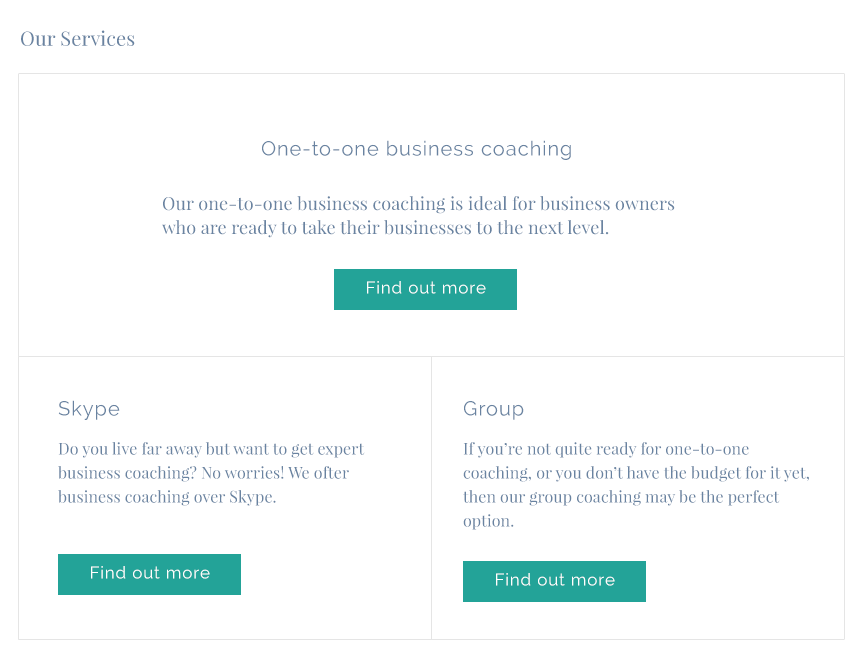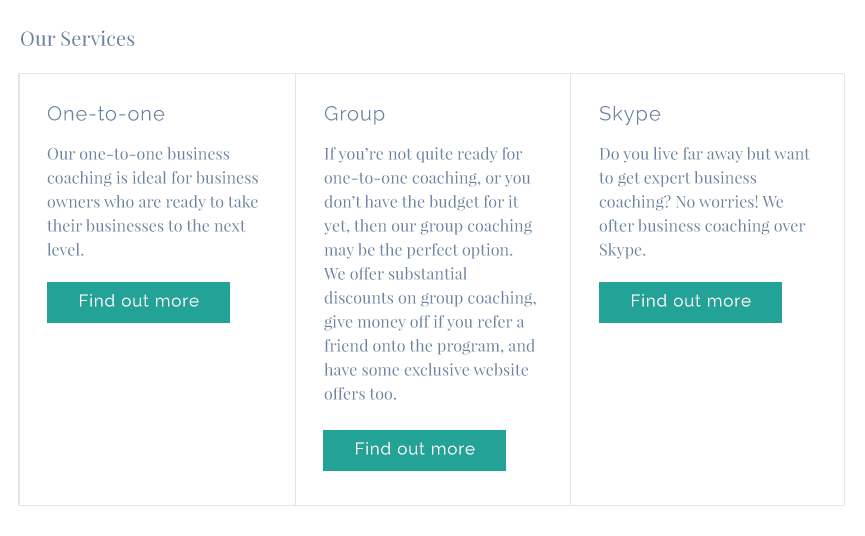Here’s a question: when you’re getting your website designed, do you start with the design first or the content first? If it’s a new website, there’ll be all new content to write. When you’re having a redesign you may want to add a new testimonials page with the comments you’re so proud of. You might add a new blog so you can share your expertise. Occasionally, with a redesign it’s just a case of refreshing the fonts and colours and leaving the text as it is. But more often than not, there’s quite a few changes you’ll want to make to your content.
Websites are an amazing tool for business owners. They can be beautiful, stunning and take your breath away. They can solve all manner of problems, like how to give your customers your very latest product prices. They can save you money by keeping your clients up-to-date with your latest services without you having to reprint your flyers or resend your PDFs. But let me put it to you: websites in all their glory are a bit useless unless they have relevant, engaging content that grabs and inspires your customers.
Your website visitors want to find things out
Have you ever visited a website to check when a particular restaurant is open? You wade through picture of their new renovations. You sit patiently through twelve beautiful sliding images with various messages on. You scroll past the nutritional information about all their meals. All you want to know right now is what time you can rock up and eat their food.
Web design should do its best to look beautiful and to match your branding. There’s nothing wrong with clever animations and stunning visuals. But more often than not visitors are coming to your website to find things out. It’s your job to give them the information they want.
Content is crucial for a good design
It’s a conundrum I often face as a web designer: clients want a new website but haven’t written any content for it yet. It’s like an architect being asked to design a house for someone without knowing who’s going to be living in it. How do you know how many bedrooms it’s going to need if you don’t know how many people are going to be living there? Should it be all on the ground floor or would a penthouse apartment be suitable?
It’s the same for a new website design. Knowing what’s going to be on the website is crucial for knowing what’s best to design.
We want to see the design!
The main reason businesses want to start the web design before they’ve written anything is that they’re excited! It’s completely understandable. When a design works well it can speak volumes about your business and your brand.
I found this recently when I redesigned my own website. I was so tempted to rush into the design. I wanted to see how it would look. I wanted to launch it as soon as I could because I was eager to share my new branding and ideas. But I knew that if I sat down and wrote the content first, it would allow me to use the design to get my message across to the right clients.
Another reason people want to start with the design is that they are so busy. Writing the body copy for your website takes time. And uninterrupted snippets of time are hard to come by when you run a business. Business owners rarely have dedicated time to spend on their website design. But it will make such a difference if you can make it a priority. Sit down and craft compelling copy to attract your ideal client, and describe to them how you can solve their problems. Or hire a copywriter who can get to know your business and write the content for you.
Why start with content
“Just fill the design with ‘lorem ipsum’ and I’ll add the content later.” It’s a phrase that makes my heart drop a little. ‘Lorem ipsum’ can be a useful little filler in a design. You can use it to show how the new blog will look when it’s got twenty blog posts, even though you’re only launching with one. But the issue with ‘lorem ipsum’ is it’s meaningless and it lacks context. Here’s how starting with content can help you end up with a better website.

It helps with emphasis.
Picture this: you have a design for the business coaching services you offer your clients. It looks great on the new homepage and matches your modern, minimalist style. Then you add your content.
It still looks great, but you’d prefer if new clients signed up to your one-to-one coaching. This is the part of your business you’re really passionate about. You’ve had so much enjoyment making a difference to those clients you’ve worked with on a one-to-one basis. You’ve loved being able to delve really deep into their brand. This is definitely the service you want to stand out.
If you’d started with the content first, the one-to-one coaching could have been emphasised more than the other two services. You’d be encouraging more people to click through to your amazing and compelling sales page that you’ve worked so hard to produce.

It helps with spacing
You’ve finished writing the blurbs for your services now. You’ve pasted your content in but it looks really unbalanced. You have some great offers on group coaching and you want people to know about it!

If you started with the real content, you could have stacked the services on top of each other rather than having them side by side. This would make the spacing look more balanced. At full width, the length of blurbs don’t look that different.

It prevents you from editing content to fit the design
Sure, you could have left out the text about the group discounts. But how would your potential clients know about it? Why leave out information that you want your customers to know? Your website should work for you to emphasise the messages you want to get across. All the examples above have the same style. But starting with the content means you don’t have to compromise on what you want to say to your customers.
It means you only have to pay for one design
Once you’ve invested in a new website you don’t want to have to redesign it again once you’ve finished writing the content. Don’t have something designed, then adjust all the different elements once you’ve put the new content in. Save yourself a job and write it first.
You’ll be ready to go live once the new site is created
It’s so sad when a new website sits there for months because the content hasn’t been written yet. The unpublished website gets more and more out of date. Writing content at the beginning means you can go live as soon as the website has been built. And the design will still be fresh and relevant.
It helps clarify your business, brand and goals
Most importantly, the process of writing your website content can help you to think through your business and your online strategy. Think about the reasons you want a website in the first place. What is the purpose of your business having a website? I don’t mean, why do you want a new design (e.g. the old website looks dated), but why do you need a website in the first place?
Is it going to be an online brochure of your latest logo designs so that potential customers can scroll through page after page of stunning and thoughtful logo designs so they absolutely *must* get in contact with you for their logo? Are you a small shop in a cosy little village who wants an e-commerce shop so not only can you sell to people in the next village without them stepping foot in the shop, but to people in the next county and across the globe? Or have you got an amazing new idea for a product? You want to gather as many email addresses of interested people so on the launch day you can send a link to buy it straight to thousands of people’s inbox.
Thinking about this will make sure your website is structured and designed in a way that leads your customers through your website towards your chosen calls-to-action. It will lay the foundations for your website design.
How do you tackle writing content for a website?
With a bit of encouragement, you can write your website copy and have a super smooth design process. Here’s five steps to inspire you and get your creativity flowing.
Step one: Know who and what the website is for
A good place to start is to clarify what the website is going to do for your business. Don’t just think about it, but take out a notebook, grab your favourite pen and answer the following questions:
- What’s the purpose of having a website? What’s it going to do for my business?
- Who is my website aimed at? Include client personas if you have them. It may be one group of people, or several.
- What is your main message? What do you want all visitors to your website to go away knowing about your brand or business?
- What’s the call to action? You may have several for different types of customer. Or have a couple of calls-to-action for customers at different stages of the sales process.
Step two: Start with what you have
Remember at school when you used to begin by writing your name, title and date on each bit of paper? It always feels good to get something written down. It’s very hard to start with a blank page, so start with what you have. Gather everything you have already. You may have content on your old website, a business card, documents you send to potential clients, flyers or promo materials.
Step three: Choose your tools.
Where do you write best? Where can you write quick enough to get all the ideas in your head down on paper. There are hundreds of different apps to write with. The content is only going to be there temporarily so simply choose your favourite. Here are a few suggestions:
- Microsoft Word. You could use it with your eyes closed. You know where all the buttons are. The built in thesaurus will make your body copy really pop. And that red squiggly underline will let you know where you’ve made a spelling mistake.
- Google Docs. It’s great for collaboration. Get the rest of the team involved. You could all be writing copy and it’ll be finished in no time!
- Hemmingway. Perfect for minimising distractions. Those colour coded highlights are going to make sure your clients can read your body copy with ease.
- Evernote. Super for when you’re on the move. Take your phone out of your pocket and write your copy in those spare little moments throughout your day.
Step four: Make a new page for each of your website pages
Grab your sitemap and put the title of each website page at the top of a new page. Then note down:
- Who are you writing the content for?
- How does it fit into your sales process?
- What do you want the client to know once they’ve read the page?
- What action do you want the reader to take after reading? (What is the call-to-action?)
Now, when you write your content you know what you want to achieve.
Step five: Fill out the pages
Make a bullet point list of what the page needs to include. For example, on your contact page your might want to include:
- your opening hours
- links to your social media accounts
- a map
- your telephone number
- your address
- the directions from a major train/bus station
- a photo of your shop
- your email address
- a contact form
Order it from most important to least important. That way people who don’t read the whole page will still get the key information. Finally, expand on each bullet point, e.g.
- We’d love your to come and sample our handmade jams and chutneys. Our opening hours are 9am til 4pm from Monday to Saturday.
- You can follow us on Twitter, Facebook and Instagram for our very latest updates.
Carry on until all your bullet points have become sentences. Then you can have a read through to check that everything flows. And give yourself a huge reward for getting it all done!





